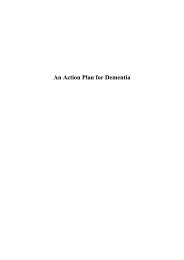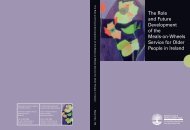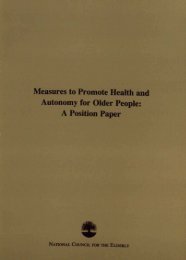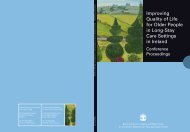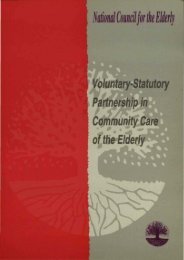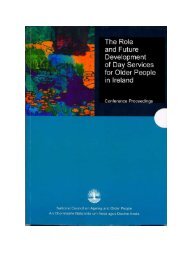From Ageism to Age Equality: Addressing the Challenges ...
From Ageism to Age Equality: Addressing the Challenges ...
From Ageism to Age Equality: Addressing the Challenges ...
Create successful ePaper yourself
Turn your PDF publications into a flip-book with our unique Google optimized e-Paper software.
Long-term care is ano<strong>the</strong>r area of importance for some older people. There is a need for clarityregarding entitlements and for core standards of provision <strong>to</strong> be established and moni<strong>to</strong>red. Thisshould be reinforced by an independent advocacy service for older people who are thinking aboutentering long-term care provision.Lifelong LearningFinally, lifelong learning needs <strong>to</strong> be a focus for investment in older people. Access for older people<strong>to</strong> education and training opportunities is important <strong>to</strong> facilitate participation in society and in <strong>the</strong>economy; <strong>to</strong> secure access <strong>to</strong> cultural activities and sustain and develop <strong>the</strong> individual person; and<strong>to</strong> ensure an awareness of one’s rights and a confidence in asserting <strong>the</strong>m where necessary.Older people have <strong>the</strong> same right of access <strong>to</strong> education and training as all o<strong>the</strong>r adults. There can,however, be hidden barriers for some older people including low levels of educational attainment, lowliteracy levels, lack of confidence and teaching approaches that alienate older people. Investmentcould usefully be made in effective information provision for older people on education and trainingopportunities, and in tailoring education and training opportunities <strong>to</strong> meet <strong>the</strong> specific needs andaspirations of older people.ParticipationWe have noted that implementing equality for older people requires effective equality legislation,institutional/organisational change and new investment. These can usefully be accompanied withstrategies <strong>to</strong> include older people and <strong>the</strong>ir organisations in <strong>the</strong> decisions that must be made.Older people’s organisations at national and local levels have a key role <strong>to</strong> play in this decisionmaking.Working with <strong>the</strong>se organisations is an effective way of identifying and articulating <strong>the</strong>specific interests of older people. This, however, is no easy task. Participation in decision-makingdemands significant time and effort; it requires skills in negotiation and policy development; andsystems of accountability <strong>to</strong> identify <strong>the</strong> core issues for older people and renew this agenda on anongoing basis. New platforms can be exploited for organisations <strong>to</strong> come <strong>to</strong>ge<strong>the</strong>r <strong>to</strong> pool ideas,strategies and agendas for change. This requires resources and it is harder <strong>to</strong> get resources forparticipation than for <strong>the</strong> provision of a service. Yet such resources will be crucial if older people’sorganisations are <strong>to</strong> continue this important role <strong>to</strong> good effect long in<strong>to</strong> <strong>the</strong> future.67ConclusionsIn conclusion, it is important <strong>to</strong> highlight that equality for older people must be equality for all olderpeople. Older people are a diverse group, in terms of gender, ethnicity, sexual orientation,ability/disability, family status, marital status and religion, and this diversity needs <strong>to</strong> be taken in<strong>to</strong>account if <strong>the</strong> equality strategy is <strong>to</strong> be effective. It is important <strong>to</strong> review <strong>the</strong> equality strategy forits capacity <strong>to</strong> take account of this diversity. The legislation is a useful starting point with itscoverage of nine different grounds: older people are covered specifically by <strong>the</strong> age ground but alsoas members of <strong>the</strong> o<strong>the</strong>r eight grounds.Institutional or organisational change will require an equality infrastructure that integrates a focus onolder people within <strong>the</strong> wider nine ground equality focus. Likewise, age proofing needs <strong>to</strong> be<strong>From</strong> <strong><strong>Age</strong>ism</strong> <strong>to</strong> <strong>Age</strong> <strong>Equality</strong>: <strong>Addressing</strong> <strong>the</strong> <strong>Challenges</strong>





